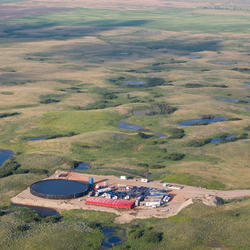Methods Development
Methods Development
Filter Total Items: 27
Advanced PFAS Measurement Methods
Environmental Health Program scientists, in collaboration with other USGS scientists, are developing complementary field and laboratory methods and capabilities to detect and quantify a range of target and nontarget per- and polyfluoroalkyl substances (PFAS) and indicator compounds at low levels (parts per trillion) in a variety of environmental matrices. The PFAS Integrated Science Team is...
Energy Integrated Science Team
The Energy Lifecycle Integrated Science Team focuses on the potential for contaminant exposures in the environment that might originate from energy resource activities including, extraction, production, transportation, storage, extraction, waste management and restoration. Perceived health risks to humans and other organisms will be distinguished from actual risks, if any. If actual risks are...
Can There be Unintended Benefits when Wastewater Treatment Infrastructure is Upgraded?
Science from the U.S. Geological Survey (USGS) and other entities has shown that a mixture of natural and synthetic estrogens and other similar chemicals are discharged from wastewater treatment plants (WWTPs) to streams and rivers.
Food Resources Lifecycle Integrated Science Team
The team studies the movement of toxicants and pathogens that could originate from the growing, raising, and processing/manufacturing of plant and animal products through the environment where exposure can occur. This information is used to understand if there are adverse effects upon exposure and to develop decision tools to protect health.
Unique Methods Used to Understand Frog Exposure to Pesticides in Agricultural Settings
Adult frog exposure to pesticides in aquatic and terrestrial habitats was quantified using a novel combination of radio telemetry and passive sampling techniques to better understand factors affecting frog health and survival in agricultural landscapes.
Bioactive Chemicals Research Laboratory
The Bioactive Chemicals Research Laboratory applies a collaborative transdisciplinary approach to conduct research to minimize the risk to human and aquatic organism health from exposure to contaminants in water supplies.
Michigan Bacteriological Research Laboratory
Microbiologists at the Michigan Bacteriological Research Laboratory (MI-BaRL) use a wide array of traditional and modern molecular approaches to evaluate microbial pathogens and antimicrobial resistance pathways in the environment.
Environmental Chemistry Core Technology Team
About the Research The Environmental Chemistry Laboratory Core Technology Team (CTT) as part of the Environmental Health Program develops and applies innovative methods of sampling and analysis to answer critical questions about the occurrence, distribution, fate and transport, and biological exposure of chemical in all environmental matrices (water, air, tissues, sediments, and others).
New Method Can Measure Naturally Occurring Element Exposure in Hummingbirds Without Harm
Seventeen naturally occurring trace elements, including those associated with adverse health impacts when birds are exposed to toxic levels (iron, lead, mercury, selenium, zinc, cadmium, and arsenic) were measured in small birds without harm. The nonlethal method was developed for hummingbirds, with Anna's hummingbirds ( Calypte anna ) as a test species and can be more broadly applied to other...
Endocrine Disrupting Compounds in the Chesapeake Bay Watershed Science Team
The Chesapeake Bay is the largest estuary in the United States and provides critical resources to fish, wildlife and people. For more than a decade, recreational fish species have been plagued with skin lesions and intersex conditions (the presence of male and female sex characteristics in the same fish) that biologists attributed to exposures to endocrine disrupting chemicals (EDCs)...
USGS Scientist Receives Award for Assistance with National Wetlands Assessment
U.S. Geological Survey (USGS) scientist Dr. Keith A. Loftin received the U.S. Environmental Protection Agency (EPA) Office of Water's Achievement in Science and Technology Award for his contributions to the National Wetlands Condition Assessment.
Recognition for a USGS Scientist in Service to Others
U.S. Geological Survey (USGS) scientist Dr. Michael T. Meyer has had a prolific career, publishing 60 journal articles and 45 USGS publications. Mike's publication record has recently led to his designation as a Thomson Reuters Highly Cited Researcher, ranking among the top 1 percent of researchers from 2002 to 2012 for most cited documents in their specific field (Environment/Ecology). He was...













